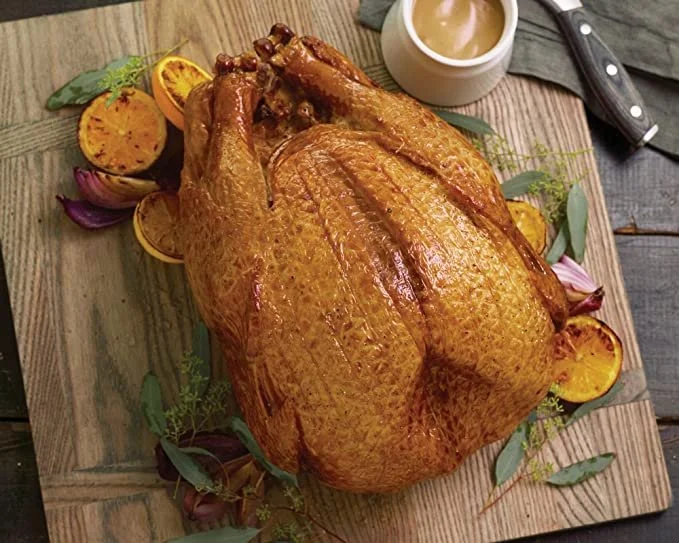Turkey
Thanksgiving
As Thanksgiving approaches, it’s time to talk turkey. There are many questions surrounding the age-old tradition of cooking turkey, such as whether to buy fresh or frozen, and how to safely thaw a turkey.
Buying and storing
If you buy a fresh turkey, check the date on the package and purchase only if the date has not passed. If the date is a “sell by” date, that is the last day the turkey can be sold. It is best to prepare the turkey by that date also. If it is a “use by” date, cook it by that date.
Fresh turkeys should be kept below 40 degrees Fahrenheit in the refrigerator until you’re ready to cook it. Put the bird on a tray or pan to catch any juices.
When serving fresh turkey, allow for one pound of turkey per person.
Don’t buy fresh pre-stuffed turkeys. If not handled properly, any harmful bacteria that may be in the stuffing can multiply very quickly.
The U.S. Department of Agriculture recommends buying pre-stuffed turkeys only if they are frozen and display the USDA or state mark of inspection on the package. These turkeys are safe because they’ve been processed under controlled conditions.
Pre-stuffed turkeys should be cooked frozen, not thawed. Follow package directions for proper handling and cooking. Allow 1¼ pounds of turkey per person.
Thaw properly
If you choose a frozen turkey, allow one pound per person.
Safe handling begins when you store and defrost the bird. USDA recommends three ways to thaw a turkey: in the refrigerator, in cold water or in the microwave.
Never thaw a turkey on the kitchen counter. Room temperature is a breeding ground for bacteria that can cause food safety concerns.
The basic rule for thawing a turkey in the refrigerator is 24 hours of thawing time for every five pounds of turkey. Once thawed, refrigerate the turkey for no more than one to two days before you cook it.
If you don’t have room in the refrigerator for a big bird, use the cold water thawing method. Follow these steps:
Submerge the bird or cut-up parts in cold water in its airtight packaging or in a leak-proof bag.
Allow about 30 minutes defrosting time per pound of turkey.
Change the water every 30 minutes to be sure it stays cold.
The following times are suggested for thawing a turkey in water:
8 to 12 pound turkey, 4 to 6 hours
12 to 16 pound turkey, 6 to 8 hours
16 to 20 pound turkey, 8 to 10 hours
20 to 24 pound turkey, 10 to 12 hours
Cook the turkey immediately after it hass thawed.
Turkeys can be kept frozen indefinitely, however for best quality, they should be wrapped in freezer packaging and cooked within one year.
The third way to thaw a turkey is in the microwave. Because every microwave is different, it’s very important to carefully follow the manufacturer instructions. The instruction manual should tell you how long to defrost per pound of turkey and what kind of container to put the bird in.”
Microwave-thawed turkeys should be cooked immediately after thawing.
Turkey by the Numbers
According to USDA’s Agricultural Marketing Service, the U.S. is the world’s largest turkey producer and largest exporter of turkey products. An estimated 46 million turkeys will be sold and cooked during the holidays this year.
A small percentage of the birds on holiday tables will be wild turkeys hunted on private and public lands. There are more than 7 million wild turkeys roaming the countryside, but their numbers were not always that robust. According to the National Wild Turkey Federation, the native U.S. game bird faced extinction in the 1930s.
Today, there are roughly 5 million Eastern wild turkeys in 38 states and four Canadian provinces. The Rio Grande species of wild turkey is the second-largest population, with more than 1,000 found in North America. Rio Grande wild turkeys are native to the Plains states and grow to 4 feet tall but with longer legs than the Eastern wild turkey.
Smaller populations of wild turkeys include the Osceola found primarily on the peninsula of Florida that number between 80,000-100,000; Merriam’s wild turkeys in the ponderosa pine, western mountain regions of the U.S. that number 334,000 ; and a relative handful – 700 or so – oGould’s wild turkeys found in southern portions of Arizona and New Mexico.
Only two species of turkeys are under the scientific genus Meleagris: Meleagris gallopavo, or the North American wild turkey that includes five distinct subspecies, and Meleagris ocellata, the oscillated turkey that exists only in a 50,000-square-mile area that includes parts of Mexico, Belize, and Guatemala.

